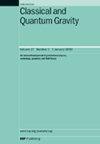在超大质量尺度上打破黑洞的独特性
IF 3.7
3区 物理与天体物理
Q2 ASTRONOMY & ASTROPHYSICS
引用次数: 0
摘要
在广义相对论中,所有的渐近平坦、平稳和轴对称的真空黑洞都用克尔解来描述。在GR之外,有一种普遍的期望,即与克尔解的偏差随着视界曲率的增加而增加。我们通过证明在标量-高斯-博内理论中,黑洞在一个有限的,可调节的黑洞质量窗口中缩放,从上到下有界,挑战了这一期望。在这个理论中,曲率尺度和紧度之间存在相互作用,我们期望这可以保护中子星和其他不太紧的物体免受尺度化的影响。此外,这个理论是第一个避免了早期宇宙宇宙学的灾难性不稳定性的理论,这种不稳定性影响了以前的尺度化模型。在这个理论中,黑洞的唯一性可以在超大质量黑洞尺度上被打破,而恒星质量黑洞仍然可以用广义相对论的解来很好地描述。为了探索这种情况,有必要对超大质量黑洞进行观测。本文章由计算机程序翻译,如有差异,请以英文原文为准。
Breaking black-hole uniqueness at supermassive scales
In general relativity (GR), all asymptotically flat, stationary and axisymmetric vacuum black holes are described by the Kerr solution. Beyond GR, there is a prevailing expectation that deviations from the Kerr solution increase with the horizon curvature. We challenge this expectation by showing that, in a scalar-Gauss–Bonnet theory, black holes scalarize in a finite, adjustable window of black-hole masses, bounded from above and below. In this theory, there is an interplay between curvature scales and compactness, which we expect to protect neutron stars and other less compact objects from scalarization. In addition, this theory is the first to avoid the catastrophic instability of early-Universe cosmology that affects previous scalarization models. In this theory, black-hole uniqueness can be broken at supermassive black-hole scales, while stellar-mass black holes remain well-described by the general relativistic solution. To probe this scenario, observations targeting supermassive black holes are necessary.
求助全文
通过发布文献求助,成功后即可免费获取论文全文。
去求助
来源期刊

Classical and Quantum Gravity
物理-天文与天体物理
CiteScore
7.00
自引率
8.60%
发文量
301
审稿时长
2-4 weeks
期刊介绍:
Classical and Quantum Gravity is an established journal for physicists, mathematicians and cosmologists in the fields of gravitation and the theory of spacetime. The journal is now the acknowledged world leader in classical relativity and all areas of quantum gravity.
 求助内容:
求助内容: 应助结果提醒方式:
应助结果提醒方式:


